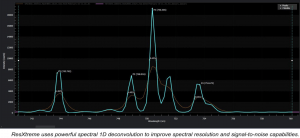Resources
Datasheets:
Datasheet
Videos:
Fundamentals of Spectroscopy
Technical Notes:
IntelliCal-Automated wavelength and intensity calibration routines significantly improve accuracy of recorded spectra
Automated wavelength and intensity calibration routines significantly improve accuracy of recorded spectra.
Fully automated wavelength calibration method optimizes data accuracy
Patent-pending IntelliCal® calibration technology from Princeton Instruments enables fast, reliable wavelength calibration with minimal user input.
Better Imaging with a Schmidt-Czerny-Turner Spectrograph
The IsoPlane spectrograph has a unique optical design that completely eliminates field astigmatism at all wavelengths and at all points across the focal plane, and reduces coma to negligible levels. This means the IsoPlane gives sharp and spatially well resolved images across the entire CCD sensor.
Improved Spectra with a Schmidt-Czerny-Turner Spectrograph
The data in this paper have shown that by decreasing optical aberrations and increasing fluence, the IsoPlane gives spectra with better spectral resolution and SNR compared to Czerny-Turner spectrographs. Higher spectral resolution means peaks that are too close together to be resolved by a CT spectrograph can be clearly seen with the IsoPlane.
Application Notes:
Analysis of Perovskite Solar Cells via Spectral Luminescence in the 700 to 1000 nm Wavelength Range
03/23/2018 The rapid development trajectory of perovskite solar cells (PSCs) is attributable to a multitude of ongoing research efforts that target technological challenges associated primarily with device stability and process uniformity. The ability to detect efficiency-limiting defects, for example, is playing a particularly critical role in both PSC fabrication and performance improvements.
Low-Frequency Raman Spectra of Amino Acids Measured with an Astigmatism-Free Schmidt-Czerny-Turner Spectrograph: Discovery of a Second Fingerprint Region
Low-Frequency Raman Spectra of Amino Acids Measured with an Astigmatism-Free Schmidt-Czerny-Turner Spectrograph: Discovery of a Second Fingerprint Region
Microscopy and Raman Imaging: Open-system Raman microscopy
Author: Cynthia Hanson and Elizabeth Vargis
05/05/2015 Publication: Laser Focus Wolrd
An IsoPlane 160 and a PIXIS 400 CCD camera are part of a cost effective Raman microscope solution developed at Utah State University. View the article in Laser Focus World.
Real-Time Imaging of Singlet Oxygen via Innovative Microspectroscopy Instrument
New Two-Dimensional InGaAs Detector Thermoelectrically Cooled to –85°C Facilitates Scientific Research
Scientific NIR-II/ SWIR Cameras Enable Femtosecond Frequency Comb Vernier Spectroscopy
New, Deeply Cooled InGaAs Cameras Provide Ultrahigh Sensitivity for Key Spectral Range
Aberration-Free Spectrographs and NIR-Sensitive InGaAs Cameras Facilitate the Development of Carbon Nanotube Optical Sensors for Early Disease Detection
Dr. Daniel Heller and his research group at Memorial Sloan Kettering Cancer center utilized the IsoPlane 320 spectrograph and NIRvana SWIR camera in their recent research.
Acquiring and processing Raman spectral data for the C2-D stretching vibration of 2 deuterated histidine
Because of histidine’s importance and unique functionality, we wanted to map out the probe group’s sensitivity to allow for its general use in protein related research.
Advanced CCD Cameras and Imaging Spectrographs Facilitate Acquisition of Novel Femtosecond Stimulated Raman Spectroscopy Data To Improve SERS Biosensors
Accurate characterization of surface-enhanced Raman spectroscopy (SERS) biosensors, fluorescent dye molecules that hold great promise for in vivo bioanalyte detection, can often be quite difficult as the overwhelming isoenergetic fluorescence signal typically makes it challenging to measure resonance Raman cross-sections for the molecules. To overcome this obstacle, researchers at the University of Minnesota in Minneapolis recently utilized etalonbased femtosecond stimulated Raman spectroscopy (FSRS), a technique designed to acquire a stimulated Raman signal without strong fluorescence or interference from signals resulting from other four-wave mixing pathway
Solar cell inspection via photoluminescence imaging in the NIR/SWIR
Scientific-grade, deep-cooled, large-format InGaAs FPA cameras such as the NIRvana from Princeton Instruments will enable researchers to observe photoluminescence emission at longer wavelengths and rapidly obtain more detailed information about defects within multicrystalline silicon solar cells.
Ultra-High-Speed, Time-Resolved Spontaneous Raman Scattering Spectroscopy in Combustion
The recent use of a new diagnostic apparatus to measure the dynamics of each individual molecular species, as opposed to simply acquire bulk information (e.g., pressure), points to the possibility of performing temperature and frequency analyses of species in combustion.
Low-frequency Raman Spectra of Carbon Nanotubes Measured with an Astigmatism-free Schmidt-Czerny-Turner Spectrograph
An IsoPlane has been interfaced to a low frequency Raman module that enables measurement of peaks with Raman shifts as low as 10 cm-1 using only a single stage spectrograph.
Accessories/ Related Products

![SpectraProHRS-family-all3-sm[1]](https://deltaphotonics.com/wp-content/uploads/2018/10/SpectraProHRS-family-all3-sm1.jpg)

